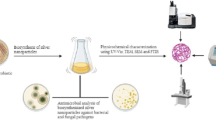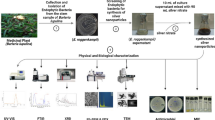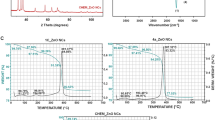Abstract
The present study investigates the sustainable biosynthesis of selenium nanoparticles utilizing different probiotic strains namely Lactobacillus delbrueckii sub. sp. bulgaricus, Lactobacillus rhamnosus, Streptococcus thermophiles and mixed culture. The synthesis and analysis were concentrated on using multiple analytical techniques, including thermogravimetric analysis-differential scanning calorimetry, X-ray diffraction, scanning electron microscopy, dynamic light scattering, and energy-dispersive X-ray spectroscopy. Major functional groups were identified by FTIR analysis that include conjugated ketones (C=O stretching) at 1648.82 cm−1 to 1688.54 cm−1, halo compounds (C–Br stretching) at 448.85 cm−1 to 879.54 cm−1, and fluoro compounds (C–F stretching) at 668.10 cm−1 to 1065.89 cm−1. Based on strain-specific measurements using SEM and TEM, the size of the nanoparticles ranged from 16 nm to 68.96 nm in diameter. Both extracellular and intracellular synthesis of the particles were identified. Significant amount of selenium were found using EDX analysis, with Lactobacillus rhamnosus and mix culture having the highest and the lowest concentrations at 97.50% and 90.58% by weight, respectively. Zeta potential measurements, indicating high colloidal stability, ranged from − 27.9 mV to − 23.1 mV and demonstrated that the nanoparticles synthesized by Lactobacillus rhamnosus was most stable among all. The synthesized nanoparticles were purely amorphous, according to XRD patterns. The TGA–DSC measurement showed that the nanoparticles exhibit varied levels of weight loss at different phases while being thermally stable. Lactobacillus rhamnosus showed maximum viability that is 8.67 log CFU/g and the least was seen in mix culture that is 7.22 log CFU/g. With applications in food fortification and biomedicine, this study highlights the potential of using probiotic strains for the synthesis of selenium nanoparticles. It also highlights an innovative approach that combines the fields of nanotechnology as well as biotechnology for sustainable and biocompatible solutions in the field of Food Science and Technology.
Graphical abstract





Similar content being viewed by others
Data availability
Data will be provided on request.
References
P.P. Reddy, M.S. Rao, Introduction to nanoscience and nanotechnology. Recent Trends Latest Innov. Life Sci., 56–96 (2022)
M.K. Ray, A.K. Mishra, Y.K. Mohanta, S. Mahanta, I. Chakrabartty, N.A. Kungwani, R.N. Pudake, Nanotechnology as a promising tool against phytopathogens: a futuristic approach to agriculture. Agriculture 13(9), 1856–1895 (2023). https://doi.org/10.3390/agriculture13091856
L.H. Duntas, S. Benvenga, Selenium: an element for life. Endocrine 48, 756–775 (2015). https://doi.org/10.1007/s12020-014-0477-6
J. Sarkar, D. Mridha, M.A. Davoodbasha, J. Banerjee, S. Chanda, K. Ray, J. Sarkar, A state-of-the-art systemic review on selenium nanoparticles: mechanisms and factors influencing biogenesis and its potential applications. Biol. Trace Elem. Res. (2023). https://doi.org/10.1007/s12011-022-03549-0
Z. Zhang, J. Lv, L. Pan, Y. Zhang, Roles and applications of probiotic Lactobacillus strains. Appl. Microbiol. Biotechnol. 102, 8135–8143 (2018). https://doi.org/10.1007/s00253-018-9217-9
R. Malaka, F. Maruddin, Z. Dwyana, M.V. Vargas, Assessment of exopolysaccharide production by Lactobacillus delbrueckii subsp. bulgaricus ropy strain in different substrate media. Food Sci. Nutr. 8(3), 1657–1664 (2020). https://doi.org/10.1002/fsn3.1452
A.L.B. Penna, A.T. Paula, S.N. Casarotti, V. Diamantino, L. Silva, Overview of the functional lactic acid bacteria in the fermented milk products. Benef. Microbes Fermented Funct. Foods 1, 100–154 (2015)
K. Spyridopoulou, E. Tryfonopoulou, G. Aindelis, P. Ypsilantis, C. Sarafidis, O. Kalogirou, K. Chlichlia, Biogenic selenium nanoparticles produced by Lactobacillus casei ATCC 393 inhibit colon cancer cell growth in vitro and in vivo. Nanoscale Adv. 3(9), 2516–2528 (2021). https://doi.org/10.1039/D0NA00984A
S.K. Filippov, R. Khusnutdinov, A. Murmiliuk, W. Inam, L.Y. Zakharova, H. Zhang, V.V. Khutoryanskiy, Dynamic light scattering and transmission electron microscopy in drug delivery: a roadmap for correct characterization of nanoparticles and interpretation of results. Mater. Horiz. 10(12), 5354–5370 (2023). https://doi.org/10.1039/D3MH00717K
H. Alam, N. Khatoon, M.A. Khan, S.A. Husain, M. Saravanan, M. Sardar, Synthesis of selenium nanoparticles using probiotic bacteria Lactobacillus acidophilus and their enhanced antimicrobial activity against resistant bacteria. J. Clust. Sci. 31, 1003–1011 (2020). https://doi.org/10.1007/s10876-019-01705-6
T. Shanmugasundaram, M. Radhakrishnan, V. Gopikrishnan, R. Pazhanimurugan, R. Balagurunathan, A study of the bactericidal, anti-biofouling, cytotoxic and antioxidant properties of actinobacterially synthesised silver nanoparticles. Colloids Surf. B 111, 680–687 (2013). https://doi.org/10.1016/j.colsurfb.2013.06.045
B. Ozturk Kurt, S. Ozdemir, Selenium in food chain in relation to human and animal nutrition and health, in Selenium and Nano-Selenium in Environmental Stress Management and Crop Quality Improvement (Cham: Springer International Publishing, 2022)
C. Ferro, H.F. Florindo, H.A. Santos, Selenium nanoparticles for biomedical applications: from development and characterization to therapeutics. Adv. Healthc. Mater. 10(16), 2100598 (2021). https://doi.org/10.1002/adhm.202100598
S.F. Ahmed, M. Mofijur, N. Rafa, A.T. Chowdhury, S. Chowdhury, M. Nahrin, H.C. Ong, Green approaches in synthesising nanomaterials for environmental nanobioremediation: technological advancements, applications, benefits and challenges. Environ. Res. 204, 111967–111987 (2022). https://doi.org/10.1016/j.envres.2021.111967
M.A. Ruiz-Fresneda, L.C. Staicu, G. Lazuén-López, M.L. Merroun, Allotropy of selenium nanoparticles: colourful transition, synthesis, and biotechnological applications. Microbial Biotechnol. 16(5), 877–892 (2023). https://doi.org/10.1111/1751-7915.14209
M. Kouhkan, P. Ahangar, L.A. Babaganjeh, M. Allahyari-Devin, Biosynthesis of copper oxide nanoparticles using Lactobacillus casei subsp. casei and its anticancer and antibacterial activities. Curr. Nanosci. 16(1), 101–111 (2020). https://doi.org/10.2174/1573413715666190318155801
J. Liu, L. Shi, X. Tuo, X. Ma, X. Hou, S. Jiang, B. Han, Preparation, characteristic and anti-inflammatory effect of selenium nanoparticle-enriched probiotic strain Enterococcus durans A8-1. J. Trace Elem. Med. Biol. 74, 127056 (2022). https://doi.org/10.1016/j.jtemb.2022.127056
E. Sánchez-López, D. Gomes, G. Esteruelas, L. Bonilla, A.L. Lopez-Machado, R. Galindo, E.B. Souto, Metal-based nanoparticles as antimicrobial agents: an overview. Nanomaterials 10(2), 292 (2020). https://doi.org/10.3390/nano10020292
A.V. Tugarova, P.V. Mamchenkova, Y.A. Dyatlova, A.A. Kamnev, FTIR and Raman spectroscopic studies of selenium nanoparticles synthesised by the bacterium Azospirillum thiophilum. Spectrochim. Acta Part A: Mol. and Biomol. Spect. 192, 458–463 (2018). https://doi.org/10.1016/j.saa.2017.11.050
R.G. Acres, V. Feyer, N. Tsud, E. Carlino, K.C. Prince, Mechanisms of aggregation of cysteine functionalized gold nanoparticles. J. Phys. Chem. 118(19), 10481–10487 (2014). https://doi.org/10.1021/jp502401w
A.A. Kamnev, Y.A. Dyatlova, O.A. Kenzhegulov, A.A. Vladimirova, P.V. Mamchenkova, A.V. Tugarova, Fourier transform infrared (FTIR) spectroscopic analyses of microbiological samples and biogenic selenium nanoparticles of microbial origin: sample preparation effects. Molecules 26(4), 1146 (2021). https://doi.org/10.3390/molecules26041146
G. Moreno-Martin, M. Pescuma, T. Pérez-Corona, F. Mozzi, Y. Madrid, Determination of size and mass-and number-based concentration of biogenic SeNPs synthesized by lactic acid bacteria by using a multimethod approach. Anal. Chim. Acta 992, 34–41 (2017). https://doi.org/10.1016/j.aca.2017.09.033
S.M.A. Aziz Mousavi, S.A. Mirhosseini, M. Rastegar Shariat Panahi, H. Mahmoodzadeh Hosseini, Characterization of biosynthesized silver nanoparticles using lactobacillus rhamnosus GG and its in vitro assessment against colorectal cancer cells. Probiot. Antimicrob Proteins. 12, 740–746 (2020). https://doi.org/10.1007/s12602-019-09530-z
J. Mikiciuk, E. Mikiciuk, A. Wrońska, A. Szterk, Antimicrobial potential of commercial silver nanoparticles and the characterization of their physical properties toward probiotic bacteria isolated from fermented milk products. J. Environ. Sci. Health Part B 51(4), 222–229 (2016). https://doi.org/10.1080/03601234.2015.1120614
H.H. Salama, H.S. El-Sayed, N.S. Abd-Rabou, Z.M. Hassan, Production and use of eco-friendly selenium nanoparticles in the fortification of yoghurt. J. Food Process. Preserv. 45(6), e15510 (2021). https://doi.org/10.1111/jfpp.15510
P. Eszenyi, A. Sztrik, B. Babka, J. Prokisch, Elemental, nano-sized (100–500 nm) selenium production by probiotic lactic acid bacteria. Int. J. Biosci. Biochem. Bioinform. 1(2), 148 (2011)
J. Prokisch, A. Sztrik, B. Babka, P. Eszenyi, J. Pardi, Z. Mika, M. Zommara, Novel Fermentation technology for production of selenium nanospheres (Lactomicrosel®) and its testing for feed and food applications, in 2nd International Conference on Selenium in the Environment and Human Health (China-Singapore Suzhou Industrial Park, Suzhou, 2021).
E. Akanny, A. Bonhommé, C. Commun, A. Doleans-Jordheim, F. Bessueille, S. Bourgeois, C. Bordes, Development of uncoated near-spherical gold nanoparticles for the label-free quantification of Lactobacillus rhamnosus GG by surface-enhanced Raman spectroscopy. Anal. Bioanal. Chem. 411, 5563–5576 (2019). https://doi.org/10.1007/s00216-019-01938-4
G. Abdel-Maksoud, M. Abdel-Nasser, S.E.D. Hassan, A.M. Eid, A. Abdel-Nasser, A. Fouda, Biosynthesis of titanium dioxide nanoparticles using probiotic bacterial strain, Lactobacillus rhamnosus, and evaluate of their biocompatibility and antifungal activity. Biomass Convers. Biorefinery (2023). https://doi.org/10.1007/s13399-023-04587-x
T. Huang, J.A. Holden, D.E. Heath, N.M. O’Brien-Simpson, A.J. O’Connor, Engineering highly effective antimicrobial selenium nanoparticles through control of particle size. Nanoscale 11(31), 14937–14951 (2019). https://doi.org/10.1039/C9NR04424H
W. Tang, S. Han, J. Zhou, Q. Xu, M. Dong, X. Fan, W. Li, Selective fermentation of Lactobacillus delbrueckii ssp. Bulgaricus SRFM-1 derived exopolysaccharide by Lactobacillus and Streptococcus strains revealed prebiotic properties. J. Fun Foods 69, 103952 (2020). https://doi.org/10.1016/j.jff.2020.103952
R. Fayed, A.M. Elnemr, M.M. El-Zahed, Synthesis, characterization, antimicrobial and electrochemical studies of biosynthesized zinc oxide nanoparticles using the probiotic Bacillus coagulans (ATCC 7050). J. Microbiol. Biotechnol. Food Sci. 13(3), e9962–e9962 (2023). https://doi.org/10.55251/jmbfs.9962
K. Anu, S. Devanesan, R. Prasanth, M.S. AlSalhi, S. Ajithkumar, G. Singaravelu, Biogenesis of selenium nanoparticles and their anti-leukemia activity. J. King Saud Univ. Sci. 32(4), 2520–2526 (2020). https://doi.org/10.1016/j.jksus.2020.04.018
M.C. Zambonino, E.M. Quizhpe, L. Mouheb, A. Rahman, S.N. Agathos, S.A. Dahoumane, Biogenic selenium nanoparticles in biomedical sciences: properties, current trends, novel opportunities and emerging challenges in theranostic nanomedicine. Nanomaterials 13(3), 424 (2023). https://doi.org/10.3390/nano13030424
S. Menon, H. Agarwal, S. Rajeshkumar, S.P. Jacquline Rosy, V.K. Shanmugam, Investigating the antimicrobial activities of the biosynthesized selenium nanoparticles and its statistical analysis. Bionanoscience 10, 122–135 (2020). https://doi.org/10.1007/s12668-019-00710-3
M. Ashengroph, S.R. Hosseini, A newly isolated Bacillus amyloliquefaciens SRB04 for the synthesis of selenium nanoparticles with potential antibacterial properties. Int. Microbiol. 24, 103–114 (2021). https://doi.org/10.1007/s10123-020-00147-9
A.H. Hashem, S.S. Salem, Green and ecofriendly biosynthesis of selenium nanoparticles using Urtica dioica (stinging nettle) leaf extract: Antimicrobial and anticancer activity. Biotechnol. J. 17(2), 2100432–2100467 (2022). https://doi.org/10.1002/biot.202100432
S.M. Zahedi, M.S. Hosseini, N. Daneshvar Hakimi Meybodi, W. Peijnenburg, Mitigation of the effect of drought on growth and yield of pomegranates by foliar spraying of different sizes of selenium nanoparticles. J. Sci. Food Agric. 101(12), 5202–5213 (2021). https://doi.org/10.1002/jsfa.11167
N.O. San Keskin, O. Akbal Vural, S. Abaci, Biosynthesis of noble selenium nanoparticles from Lysinibacillus sp. NOSK for antimicrobial, antibiofilm activity, and biocompatibility. Geomicrobiol J. 37(10), 919–928 (2022). https://doi.org/10.1080/01490451.2020.1799264
W. Chen, Y. Li, S. Yang, L. Yue, Q. Jiang, W. Xia, Synthesis and antioxidant properties of chitosan and carboxymethyl chitosan-stabilized selenium nanoparticles. Carbohydr. Polym. 132, 574–581 (2015). https://doi.org/10.1016/j.carbpol.2015.06.064
Y.M. Tilwani, A.K. Lakra, L. Domdi, N. Jha, V. Arul, Preparation, physicochemical characterization, and in vitro biological properties of selenium nanoparticle synthesized from exopolysaccharide of Enterococcus faecium MC-5. BioNanoScience 13(2), 413–425 (2023). https://doi.org/10.1007/s12668-023-01077-2
M.T. Yilmaz, H. Ispirli, O. Taylan, E. Dertli, A green nano-biosynthesis of selenium nanoparticles with Tarragon extract: structural, thermal, and antimicrobial characterization. LWT 141, 110969 (2021). https://doi.org/10.1016/j.lwt.2021.110969
C. Xu, L. Qiao, Y. Guo, L. Ma, Y. Cheng, Preparation, characteristics and antioxidant activity of polysaccharides and proteins-capped selenium nanoparticles synthesized by Lactobacillus casei ATCC 393. Carbohydr. Polym. 195, 576–585 (2018). https://doi.org/10.1016/j.carbpol.2018.04.110
B. Khandsuren, J. Prokisch, Preparation of red and grey elemental selenium for food fortification. Acta Aliment. 50(2), 289–298 (2021). https://doi.org/10.1556/066.2020.00332
Author information
Authors and Affiliations
Corresponding author
Additional information
Publisher's Note
Springer Nature remains neutral with regard to jurisdictional claims in published maps and institutional affiliations.
Rights and permissions
Springer Nature or its licensor (e.g. a society or other partner) holds exclusive rights to this article under a publishing agreement with the author(s) or other rightsholder(s); author self-archiving of the accepted manuscript version of this article is solely governed by the terms of such publishing agreement and applicable law.
About this article
Cite this article
Rao, V., Poonia, A. Microbial biosynthesis of selenium nanoparticles using probiotic strain and its characterization. Food Measure (2024). https://doi.org/10.1007/s11694-024-02581-z
Received:
Accepted:
Published:
DOI: https://doi.org/10.1007/s11694-024-02581-z




